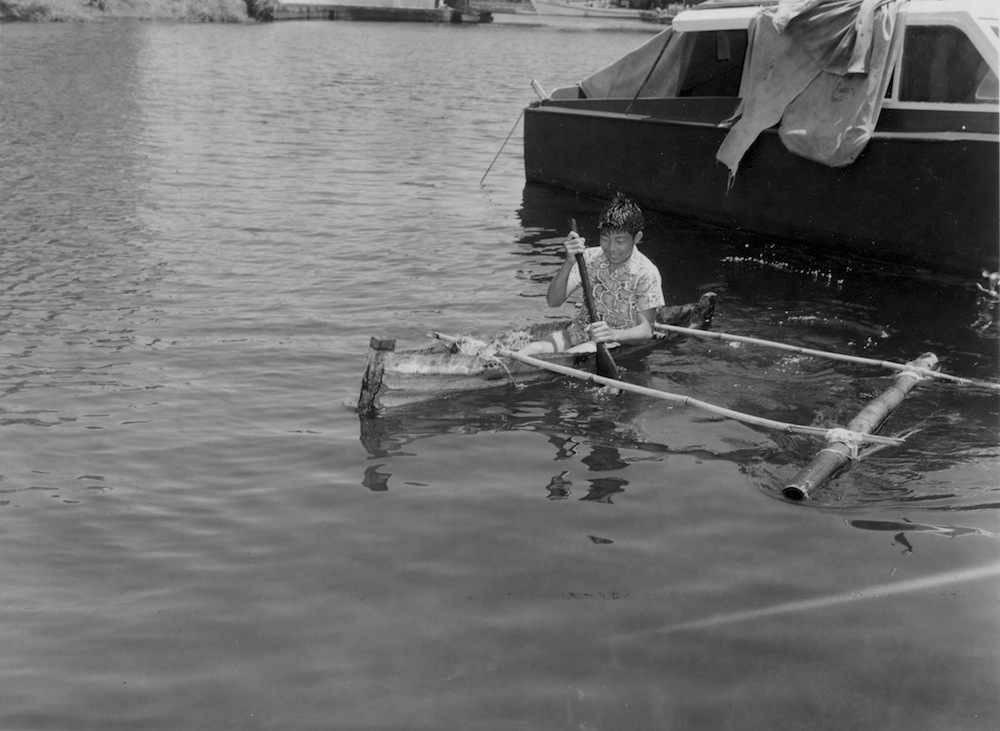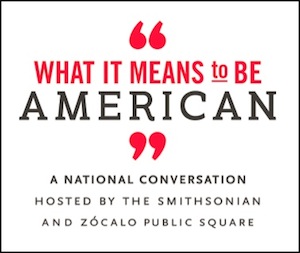
A boy’s life on Hawaii’s Big Island in the 1950s revolved around water. My elementary school in Hilo was right by Bakers Beach, a spring-fed pond called Ice Pond, and the Wailoa River. Every day after school, we used to go swimming or diving to catch fish. I practiced holding my breath in the bathtub.
 Typically using small shrimp as bait and homemade spears made out of wire hangers or bamboo and rubber, we would hunt little silver fish called aholehole or sometimes a brown, flat, bottom-dwelling fish we called opoo. We would sell what we caught to the fish market by the pound, which might get us as much as 35 cents for a dozen fish. We would use the money to buy candies like Baby Ruth bars (which cost 5 cents) and to see a movie (a quarter to get in).
Typically using small shrimp as bait and homemade spears made out of wire hangers or bamboo and rubber, we would hunt little silver fish called aholehole or sometimes a brown, flat, bottom-dwelling fish we called opoo. We would sell what we caught to the fish market by the pound, which might get us as much as 35 cents for a dozen fish. We would use the money to buy candies like Baby Ruth bars (which cost 5 cents) and to see a movie (a quarter to get in).
You can see what life as a kid in Hilo was like in a photograph taken in the late 1950s by John Howard Pierce, a photographer for the Hawaii Tribune-Herald, recently on display at the Lyman Museum here in town. It’s a photograph of yours truly, circa age 12 or 13, paddling the Wailoa River in my first homemade outrigger canoe.
I was born in 1945 in Hilo. My parents were born in Hawaii, too—my grandparents were the ones that had come over from Japan. I don’t know exactly why they came over, but I think in order to work in the sugarcane fields. My father died when I was only 3, so my mother basically raised the four of us children by herself. She worked as a housekeeper, cleaning houses and washing clothes.
It’s hard to remember why I decided to build my own outrigger, but I do remember seeing an older Hawaiian man at a pond near Reeds Bay making a canoe out of a big log from a koa or monkeypod tree. Over the course of a few months, I watched him dig a hole in the center of the log with a flat stone scraper. He shaped the pointed ends of the canoe and carved tiki faces onto it with a homemade traditional Japanese carving knife. I watched him hammer nails into it with a mallet. He was using cord he said he had braided from the fibers inside a hau tree.
I also had seen lots of photographs of outrigger canoes, which are traditional Polynesian boats that feature floats on the side that make them more stable in very rough water. So one day, I decided I would try to build one of my own with a friend. We didn’t have any of our own materials, so we scavenged them from around town. We didn’t exactly ask permission for what we took; we didn’t want a scolding. We helped ourselves to a collection of tools left by my father.
I found a sheet of corrugated iron that people used to fashion into roofs and 2-by-4 pieces of lumber from a hau tree lying around my uncle’s house. At the back of my house, we cut everything down to size and nailed the corrugated iron to the two-by-fours, which served as the front and end points of the canoe.
We also needed tar to plug the holes. We saw tar and oil dripping down telephone poles around where we lived and scraped that off to try, but it was too soft and got all over our hands. Later, we found a 40- or 50-gallon drum somewhere—back in those days, people used to get rid of rubbish or weeds by burning them in barrels with tar. The one we found still had a little tar inside.
The tar was very hard, though, so we had to use a chisel and hammer to get it off. We put those pieces into a bucket and set it to melt over hot rocks and chicken wire—kind of like a barbecue. Then we applied it to the ends of the canoe to seal it up.
My family’s house at the time was up on Kalanikoa Street, and I carried the crude iron canoe on my back over a mile down to the Wailoa River.
We added the outrigger part down there, using bamboo we found along the Wailoa River for the floats. We tied them together with cord I found around the house and hau tree fibers.
My friend and I took turns paddling the canoe when we were finished making it. It sank a lot. When boats passed by, they made waves that came into the little canoe. That’s why I look so wet in the picture.
At the end of the day, we would hide the canoe in the tall grass by the river because it was too heavy to carry back and forth. After maybe a month, though, we gave this first canoe away to some friends because we knew we could build a better one. The second time, I hammered the corrugations out of the iron, which made for a better hull, and we made it wider and longer. One time we tried to put two people in it, but that was too much weight. It sank, too.
This experience only reinforced my sense that I wanted to do something with my hands for a living. So after graduating from high school and completing basic training for the Hawaii National Guard, I enrolled in a carpentry course at Hawaii Technical School in Hilo. I became a journeyman carpenter, working in construction all over Hawaii.
Earlier this year, my nephew came to my house and said there was a picture of me at the Lyman Museum. He showed me the canoe photo on his cell phone. When I went down to the museum to talk to Miki Bulos, the archivist trying to identify all the people in the photographs, she showed me a picture of the man who had taken the photos. I recognized Pierce as one of the photographers who was at the Tribune-Herald office when I used to deliver that newspaper as a kid!
The photograph reminded me of how much fun I used to have when I was young. I still love the water. Even though the doctor tells me it’s not good for my arthritis to go swimming and diving and I get pretty sore, I still go in every chance I get.




Send A Letter To the Editors